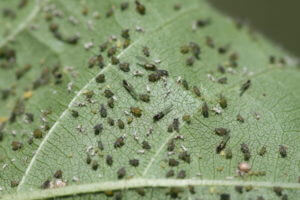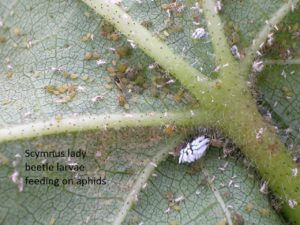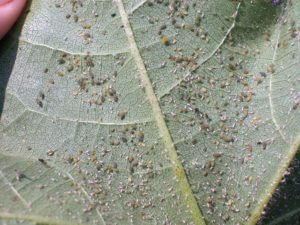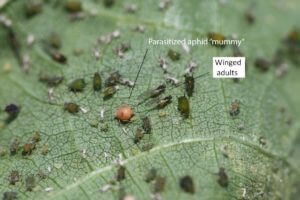
Aphids occur in most cotton fields every year but only occasionally cause economic damage. Economic damage is most likely when environmental conditions such as dry weather are already stressing cotton growth. Aphids are usually found on the undersides of leaves or feeding in the terminals. They feed by sucking sap from phloem tissue. Heavily infested leaves will often curl downward along their edges. The accumulation of honeydew causing sticky and shiny leaf surfaces often indicates the presence of aphids (or whiteflies). Severe infestations can stunt plants and reduce yields, particularly if populations persist for a long period of time. Honeydew secretions on open bolls may result in lint staining or “sticky cotton.” This is rarely a concern in Tennessee because late-season aphid infestations are generally uncommon and cleansing rains often occur prior to harvest. For more information visit the Cotton Insects Cotton Aphid Fact Sheet (W028).
The presence of honeydew or leaves that curl downward along the edge is a sign of aphid infestations. Check for aphids on the undersides of leaves. Estimate the average number of aphids found per leaf on leaves located 3-5 nodes below the top node.
Treat when aphids are numerous, honeydew is present, and plants are showing signs of stress. Treatment with insecticides is sometimes recommended when populations exceed an average of 50 aphids per leaf and honeydew is accumulating, especially under conditions of drought stress. Parasites and predators usually keep aphids populations below treatment levels. Consider the possibility of a fungal epizootic (Neozygites fresnii) before treating. This may be recognized by a sudden crashing of populations in the same or nearby fields where insecticides were not applied.
Management options
Insecticide (Trade Names) for APHIDS
| Lb Active Ingredient per Acre | Amount Formulation per Acre | Performance Rating |
| acetamiprid (Intruder Max 70WSP, Strafer Max70WSP)* | 0.026 - 0.048 | 0.6 - 1.1 oz | 8 |
| dicrotophos (Bidrin 8)* | 0.25 - 0.5 | 4 - 8 oz | 6 |
| dimethoate 4* | 0.125 - 0.5 | 4 - 16 oz | 5 |
| flonicamid (Carbine 50 WP) | 0.044 - 0.089 | 1.4 - 2.8 oz | 8 |
| imidacloprid 2.0* | 0.031 - 0.047 | 2 - 3 oz | 4 |
| imidacloprid 4.0 (Couraze Max)* | 0.031 - 0.047 | 1 - 1.5 oz | 4 |
| imidacloprid 4.6 (Admire Pro)* | 0.047 - 0.062 | 0.9 - 1.3 oz | 4 |
| sulfoxaflor (Transform 50WG) | 0.023 - 0.031 | 0.75 - 1.0 | 8 |
| thiamethoxam (Centric 40WG)* | 0.031 - 0.05 | 1.25 - 2 oz | 4 |
* Because of resistance, these products give variable performance and may fail or only provide suppression, especially if the same class of insecticide was used previously.
- In the Mid-South, cotton aphids have developed resistance to several classes of insecticides including pyrethroids, neonicotinoids, and several organophosphates (OP’s). Spray for aphids and other pests only as needed to help reduced selection for insecticide resistance.
- When possible and especially prior to bloom, avoid using insecticides that disrupt populations of natural enemies such as pyrethroid insecticides and acephate.





